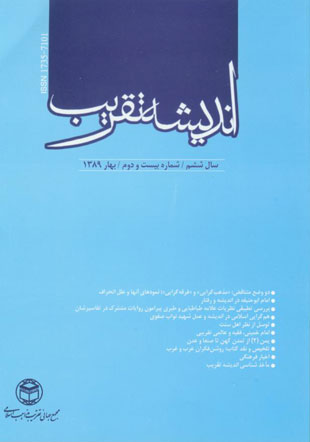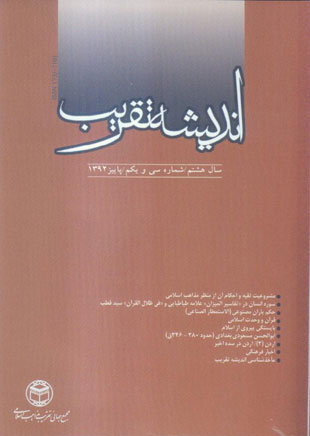فهرست مطالب

فصلنامه اندیشه تقریب
پیاپی 22 (بهار 1389)
- تاریخ انتشار: 1389/06/01
- تعداد عناوین: 14
-
صفحه 5
- مقالات اندیشه ای
-
صفحه 29
-
صفحه 73
- پیشگامان تقریب
-
صفحه 89
- سرزمین های جهان اسلام
-
صفحه 105
- گزارشی از یک کتاب
-
صفحه 143
- ماخذشناسی اندیشه تقریب
-
صفحه 191
-
صفحه 205
-
Page 11In spite of having scientific and intellectual differences between the followers of religions, they developed a good and friendship relationships; this situation can teach us a lesson. The relationship was so good that in some cases some of the scholars of one sect would teach the students of other sects and would expand the methods of other religions among themselves; they would also give permission of quoting Ahadith to eachother. They could develop such good relations since they overlooking minor differences and focused on the overall good of Muslim community. Unfortunately, this good relationship did not last long and soon the Muslim community faced with fanaticism and deviation. This article the factors causing some of the deviations are expanded upon.
-
Page 29Understanding and getting to know the relation of the leaders of Islamic sects-all of whom lived during approximately the same time- can play an important role in bringing about peace and creating peaceful coexistence of the followers of different religions; particularly because all these sects were originated from one religion and all of them are related to one prophet. Accordingly, this article expands upon the features of Abu Hanife who is one of the leaders of most famous fourfold Islamic sects and whosefollowers account for the largest sect in Islam world. This paper also explains Abu Hanife’s aspects including his scientific and intellectual life, political life, relation with jurisprudence and Islamic epistemology, and support for the Alawiyans in fighting against the Omayyads during the Abassides dynasty.
-
Page 57The political-religious activities of Fadaiyan-e Islam group- led by Shahid Nawab Safavi for creating cohesion among Muslims- are outstanding among alternative activities. This issue increases in importance once Shiite fundamentalism approaches Sunni fundamentalism and the situation for theoretical and practical cooperation between both sects isimproved.During the time when Arab nationalism had dominated Palestine and the Muslim Brotherhood movement was known as a fundamentalist movement with a Sunni radical approach, the Fadaiyan-e Islam group, led by a young clergy named Mojtaba Nawab Safavi, could change the structure of those movements with their Shiite ideological approaches. They could achieve this because they put aside Sunni-Shiite ideological controversial issues and emphasized on the commonalities in such a way that most of the Islamic denominations were attracted to them.Fadaiyan-e Islam group, with their activities including reaction toIsrael’s existence announcement, participating in Islamic conferences,cooperating with Palestinian fighters, getting familiar with the ideas andgoals of Muslim Brotherhood movement all indicate that Fadaiyan-e Islamand Nawab Safavi were following the path of Islamic unity and cooperationwith the world of Islam as one of their fundamental objectives.
-
Page 73When arguing about permission of Tawasol and considering the Quranicverses and sayings of the Holy Prophet reported in the sources of Sunnidenominations upon permission of Tawasul to prophets and divineindividuals particularly the last Prophet, this question is raised: why andwho denies Tawasol to prophets including Prophet Mohammad (a.s) anddivine individuals and what are their reasons for doing so?This paper tries to indicate to the related issues and provide reasons forpermission to Tawasul to prophets and presents the Sunni scholars’viewpoints.Tawasul to the prophets particularly to the Prophet of Islam (s.a) underany circumstances (before they were physically born, during their lifetimeand after their death) is considered permissible. The raised questionsconcerning this issue are not right, that is because utilizing the prophets asmediators between man and God is neither considered polytheism nor areligious innovation and these divine lights during their lifetime and afterdeath, are capable of fulfilling the needs and interceding with God.
-
Page 89Imam Khomeini (1902-1989) entered the Howzeh of Arak city when he was 19 years old. He moved to Qom later and achieved the highest Howzebased academic level known as (Ijtihad). He married at the age of 28. While writing different books he started political activities. He continued his activities until 1978, the time when the Shah’s regime in Iran toppled and he became the leader. He also taught several students and had numerousviewpoints regarding religious cohesion and made lots of effort to unite Islamic sects, some of which are explained in this paper.
-
Page 105In the first part of this paper, we explained about how the country wasnamed Yemen, its pre-Islam and post-Islam history. Also due to historicalsignificance, some topics were addressed such as Yemen during 11th-20thcenturies, events during First World War, Yemen disputes with SaudiArabia and government of Imam Yahya after its establishment until its fall.In this part of the paper, we deal with such issues as Yemen geographyafter unification of Yemen (North and South), neighboring countries,fivefold regions and tribal- ethnical structure. Yemen society is a tribal oneand the majority of the population, approximately 86%, is Gahtani Arabs.Due to its old history, Yemen possesses valuable historical monuments.Some major events occurred in Yemen were reported in the Quran. Thispaper introduces some of the major cities and historical sites such as Sana,Eden, Ma’rab, Hazarolmout, Sarvah. The paper ends with informationabout official vacations (Islamic, national and international).


